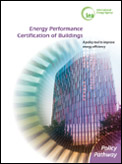The aim of the report is to provide policymakers with a “how-to” guide for designing, implementing and evaluating policies to promote energy efficient buildings.
 2 November 2010: The International Energy Agency (IEA) has launched the second report of its “Policy Pathway” series titled “Energy Performance Certification of Buildings,” at the IEA’s Clean Energy Technologies Symposium in Singapore.
2 November 2010: The International Energy Agency (IEA) has launched the second report of its “Policy Pathway” series titled “Energy Performance Certification of Buildings,” at the IEA’s Clean Energy Technologies Symposium in Singapore.
The aim of the report is to provide policymakers with a “how-to” guide for designing, implementing and evaluating policies to promote energy efficient buildings. The report notes that certifying the energy efficiency of buildings can be applied to new or existing structures. It outlines the multiple benefits of such certification, including: energy and carbon dioxide emissions reductions and other environmental benefits; increased public awareness of energy and environmental issues; lower costs for users; and improved data on buildings for future policy development.
The report analyzes the EU Energy Performance of Buildings Directive (European EPBD), as well as existing systems in other countries such as Australia, Singapore and the US. It also includes recommendations for countries interested in starting their own certification schemes to improve energy efficiency and energy savings, which are broken down into four check-list type categories on planning, implementation monitoring and evaluation.
The IEA’s Clean Energy Technologies Symposium took place at the Singapore International Energy Week 2010, and brought together regional experts on energy technology to present their analyses and policy recommendations. [Energy Performance Certification of Buildings Report] [IEA Press Release on the Clean Energy Technologies Symposium]